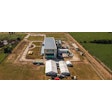A cutting edge feed-mill in Batesville, AR, stands as a monument to Ozark Mountain Poultry’s growth. OMP has grown from just 25 employees in 2001 to producing 3 million pounds of poultry products a week. In an increasingly competitive market, with many in agriculture facing a hard economic atmosphere, OMP has managed to find a business model that works for them, allowing them to grow an astonishing amount in a relatively short period of time.
Humble beginnings lead to great things
Every business starts somewhere. Even the Walmarts and Tysons of the world started with one store or farm and even before that just a simple idea. Ozark Mountain Poultry’s idea hits on what modern consumers want from agricultural products: low-priced, high-quality products.
“The great thing about us is that it’s premium quality chicken, but it’s at a price point that working families can afford,” explained Melinda Acoach, Ozark Mountain Poultry’s director of marketing. “That’s the primary reason the company was started. We think that everybody deserves high quality chicken at a good value.”
The simple philosophy of providing a quality product at an affordable price has been the driving force behind OMP’s growth. The company now provides chicken products nationwide through Walmart and Sam’s Club under the brand Forester Farmer’s Market®.
“We opened up back in April of ’01 with 25 employees,” reminisced Dr. Ed Fryar, CEO and founder of OMP. “We produced 22,000 pounds of finished product that first week. Last week, we produced 3 million pounds.”
OMP expects those numbers to keep growing. Already it employs 1,400 people throughout its infrastructure and intends to be producing 8 million live pounds by July 2016. This growth was possible through hard work, a solid idea and by finding a way to produce a unique product.
Finding a niche
According to the USDA, chicken consumption has almost doubled since 1980. Both in the United States and across the world the demand for chicken products, of all types, continues to rise.
“The chicken business has really diversified over the last 20 to 30 years, especially the last 20 years,” said Fryar. “Where it used to be, if you went back to, say, 1960, broilers were a commodity. It may have been a four-pound live-weight or a five-pound live-weight bird, but it was pretty much a commodity. It’s not that way anymore. The industry has segmented into fast-food plants (four-pound live weight), retail plants (five- to seven-pound live weight), and big bird plants (eight pounds and up). Within this segmentation you find even more segmentation. For example, some retail plants specialize in producing broilers at the lowest cost possible. Other retail plants focus on producing specialty birds such as antibiotic free or organic.”
The increase in the demand for chicken and the diversity of the companies competing to fill that demand has made for a Darwinian market. A company must find its place in it quickly or be devoured.
“We’re looking for a niche where we have a long-term and sustainable competitive advantage,” Fryar continued. “That’s what pushed us in the direction of a premium product that working families can afford. It’s more a question of survival than anything else. If we try to compete in the commodity business, we’re ‘dead meat.’”
Controlling the supply chain
Finding their niche gave Ozark Mountain Poultry the ability to grow as opportunities to pivot and expand presented themselves.

“For the first 10 years that we existed as a company, we were largely a co-packer, we didn’t have our own supply of meat or birds,” Fryar said. “We co-packed with some very good companies. It was a great business model for us, but that wasn’t a long term proposition. We started looking around for other things that we could do.”
OMP expanded its production ability by first purchasing and upgrading a Pilgrim’s Pride facility in Batesville, AR, in 2013 and followed that with the purchase of a ConAgra complex in the same city in 2016.
“Late last summer we purchased what used to be ConAgra’s plant, their cook plant, where they cook banquet food,” Fryar explained. “We’ve converted that. When we first bought the complex, it had one harvest line. Since then, we’ve added a second harvest line. Both of those are in the ConAgra building, which is now called the new OMP building. We’re in the process of adding front-half de-boning in the building.”
Batesville, AR, seemed to be the perfect match for OMP to expand its poultry operations. It provided the raw resources necessary to control the quality of a premium product along with the space to produce it in quantities that could meet demand.
“There was already a grower base in the Batesville area,” explained Stephan Barnes, vice president of operations, OMP. “There were 240 grower houses here. Now there are 365. We’re expanding those as well.”
OMP’s relationship extends to grain farmers as well, giving it an advantage when sourcing specialty grains for their in-house feed mix.
“We also own a couple of grain elevators in the area,” Acoach said. “That allows us to have direct relationships with local farmers. One of the areas we’re looking to expand in the future is non-GMO feed. That would allow us to source directly with the farmers. The elevators let us have storage to preserve the identity of it.”
With the other steps in the production process located in the area, a desire to control quality and a growing operation, building a new, modern feed mill in the area was the next logical step. Like most things it does, OMP put quality at the forefront of its new facility, to be able to provide its chickens with the best feed for the company’s current and future needs.
Building a monument
Nestled in between the rolling hills and fertile delta of Arkansas, OMP’s new feed facility rivals anything the larger poultry companies have built. Trucks continually pull in and out, delivering raw ingredients or taking finished feeds off to one of the grower houses. Completed in December 2015 by Weitz, the facility has storage for 200,000 bushels of whole grains, 1,700 tons of soybean meal, 900 tons of minor ingredients like minerals and salt and 2,600 tons of finished feed.
Like most feed mills it houses a relatively small amount of equipment. A personnel elevator from Schumacher Elevator Company takes employees between three levels. The roof is home to a Hayes & Stolz Industrial Manufacturing Ltd., bucket elevator. Scott Equipment Company made the mixer and surge hopper while GSI/Intersystems, Inc., provided the drag conveyors. These create a complex system that intertwines throughout the facility and gets the many ingredients from storage to the processing area and beyond.
The floor where much of the processing is done is home to a twin pair of Bliss Industries, LLC, hammermills for the facility and two model 7900 California Pellet Mill 500-hp motors. California Pellet Mill also provided the feeders, conditioners, crumbler, and feed cleaner.
The raw ingredient trucks pull onto scales from Rice Lake Weighing Systems and are quickly probed. If there’s no line, they can be unloaded in as little as six minutes. Two receiving legs route those ingredients at 14,000 bushels/hour. The facility will also be opening up a rail line with receiving at 14,000 bushels/hour.
The equipment allows the mill to produce 12,000 tons/week of feed running five days with two shifts, while employing 14 people.
Taking the next step
OMP’s Batesville feed mill represents everything the company stands for. It is of exceptional quality, carefully planned and built for the future. It will give OMP the ability to change with the industry.
“Right now, we’re antibiotic free with no animal by-products,” Fryar noted. “There’s a handful of companies out there that are ABF today. I think the industry is moving more and more to that ABF format. In a few years it may be very close to being a commodity. So, we’re looking at other products that will let us move into other niches that I think will work out well for us.”
Controlling their supply chain allows OMP to adapt and expand in an ever-changing market. The new feed mill in Batesville, AR, gives them more control, and therefore more flexibility than ever before, it’s a milestone for a company on the rise.
.jpg?auto=format%2Ccompress&crop=faces&fit=crop&h=48&q=70&w=48)















